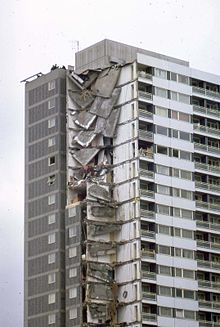Disproportionate collapse
Contents |
[edit] Introduction
 Disproportionate collapse (or progressive collapse) occurs in a building when the failure of one component leads to the progressive failure of a series of other components, often with catastrophic results. The effect is very similar to that seen in a game of Jenga, pictured.
Disproportionate collapse (or progressive collapse) occurs in a building when the failure of one component leads to the progressive failure of a series of other components, often with catastrophic results. The effect is very similar to that seen in a game of Jenga, pictured.
[edit] Ronan Point
A well-known example occurred in Newham, East London in May 1968 at a new 22-storey block of flats called Ronan Point. The reinforced concrete building featured prefabricated external wall panels. Unfortunately, a gas explosion resulted in the progressive collapse of an entire corner of the tower block, which killed four people and injured 17 other residents. The cause of the explosion was a resident striking a match to boil water which ignited the gas that was leaking from a joint in a newly-installed cooker.
The explosion blew out the load-bearing flank walls, which had been supporting the four flats directly above, lifting the ceiling and floor slab. This resulted in a house-of-cards progressive collapse as the floors above became unsupported. For further details see Ronan point.
Progressive collapse can be exploited deliberately as a demolition method to ensure a relatively quick and economic collapse if it is known the construction will respond appropriately.
[edit] Building regulations
Requirement A3 of the Building Regulations 2010 states:
‘The building shall be constructed so that in the event of an accident the building will not suffer collapse to an extent disproportionate to the cause.’
In other words, had Ronan Point been constructed in line with requirement A3, the damage would have been restricted to the floor where the explosion took place. Reducing a building’s tendency to disproportionate collapse can be met by a range of constructions set out in Approved Document B of the Building Regulations.
[edit] Pancake collapse
In the US, the term ‘pancake collapse' is sometimes used to describe the phenomenon of progressive collapse. The term was first used to describe a structural failure in the Bronx, New York, in August 1980, where a fire had weakened a structure to the extent that the floors fell successively in on one another, i.e they ‘pancaked’ down.
A similar effect was seen at the destruction of the twin towers of the World Trade Center, New York in September 2001. The fire produced by the aircraft strikes resulted in the progressive failure of the floor system; although initiated by the attacks, this was later deduced to be the primary mode of structural failure in the steel frame buildings. A number of code changes were initiated as a result of the investigation, one of which was to increase by one hour the fire resistance of structural components.
The Institution of Structural Engineers (IStructE) has published a two-volume guide to structural robustness and disproportionate collapse in buildings:
- Practical guide to structural robustness and disproportionate collapse in buildings.
- Manual for the systematic risk assessment of high-risk structures against disproportionate collapse.
[edit] Related articles on Designing Buildings Wiki
- Adam Curtis - The Great British Housing Disaster.
- Approved Document A.
- British post-war mass housing.
- Creep
- De la Concorde overpass collapse.
- Defects in construction.
- Grenfell Tower fire.
- Modular buildings.
- Offsite manufacturing.
- Prefab bungalows.
- Prefabrication.
- Ronan Point.
- Structural failures.
- The structural condition of Easiform cavity-walled dwellings (BR 130).
[edit] External references
Featured articles and news
Ebenezer Howard: inventor of the garden city. Book review.
Grenfell Tower fire – eight years on
A time to pause and reflect as Dubai tower block fire reported just before anniversary.
Airtightness Topic Guide BSRIA TG 27/2025
Explaining the basics of airtightness, what it is, why it's important, when it's required and how it's carried out.
Construction contract awards hit lowest point of 2025
Plummeting for second consecutive month, intensifying concerns for housing and infrastructure goals.
Understanding Mental Health in the Built Environment 2025
Examining the state of mental health in construction, shedding light on levels of stress, anxiety and depression.
The benefits of engaging with insulation manufacturers
When considering ground floor constructions.
Lighting Industry endorses Blueprint for Electrification
The Lighting Industry Association fully supports the ECA Blueprint as a timely, urgent call to action.
BSRIA Sentinel Clerk of Works Training Case Study
Strengthening expertise to enhance service delivery with integrated cutting-edge industry knowledge.
Impact report from the Supply Chain Sustainability School
Free sustainability skills, training and support delivered to thousands of UK companies to help cut carbon.
The Building Safety Forum at the Installershow 2025
With speakers confirmed for 24 June as part of Building Safety Week.
The UK’s largest air pollution campaign.
Future Homes Standard, now includes solar, but what else?
Will the new standard, due to in the Autumn, go far enough in terms of performance ?
BSRIA Briefing: Cleaner Air, Better tomorrow
A look back at issues relating to inside and outside air quality, discussed during the BSRIA briefing in 2023.
Restoring Abbotsford's hothouse
Bringing the writer Walter Scott's garden to life.
Reflections on the spending review with CIAT.
Retired firefighter cycles world to raise Grenfell funds
Leaving on 14 June 2025 Stephen will raise money for youth and schools through the Grenfell Foundation.
Key points for construction at a glance with industry reactions.























